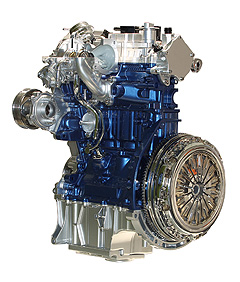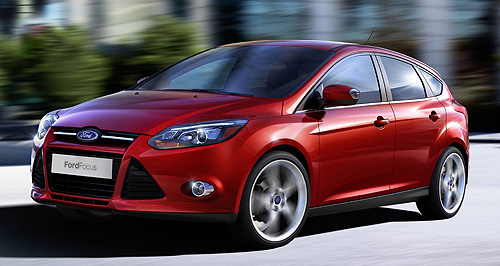Future models - Ford - FocusFocus to get Ford’s new three-pot turboTriple treat: Ford’s first three-cylinder engine will provide the European Focus small car with up to 93kW of power. Ford Oz not yet committed to 1.0-litre EcoBoost despite 2012 debut in Euro Focus10 Nov 2011 FORD of Europe has released official power, torque and fuel-efficiency figures for its new 1.0-litre three-cylinder EcoBoost petrol engine while announcing the unit will make its production debut under the bonnet of the Focus small car from next year. The Blue Oval’s Australian division would not confirm whether the engine – which produces slightly more power and torque than the existing 1.6-litre petrol powerplant while consuming far less fuel – will be offered any time soon in the Focus locally. Ford Motor Company of Australia product communications manager for passenger vehicles Justin Lacy told GoAuto “there are no plans for us to change anything immediately”, owing to the latest Focus having been launched Down Under only recently. “The next thing for us will be when we source it out of Thailand during 2012,” he said. “As to what might happen then or what happens beyond that point, it is too early for us to get into those details.” The British-developed three-cylinder engine will be initially produced in two states of tune, headlined by the 93kW version with 170Nm of torque, with 200Nm available in short bursts when an overboost facility is employed. Combined fuel consumption is 5.0 litres per 100 kilometres, with emissions of 114 grams per kilometre.  By comparison, the existing 1.6-litre petrol Focus produces 1kW and 11Nm less (41Nm with overboost taken into account) while consuming 19 per cent more fuel and emitting 21 per cent more CO2. By comparison, the existing 1.6-litre petrol Focus produces 1kW and 11Nm less (41Nm with overboost taken into account) while consuming 19 per cent more fuel and emitting 21 per cent more CO2.No torque or fuel consumption figures are provided for the lower-tuned 74kW version, but it achieves an even better CO2 output of 109g/km, which Ford claims makes it the outright petrol class leader. The new Ford engine throws down the gauntlet to Volkswagen Group, considered one of the world’s leaders in downsized engines. Ford’s unit achieves similar outputs with three cylinders and one litre of displacement as VW’s forced-induction 1.2-litre 77TSI and 1.4-litre 90TSI four-cylinder engines, which both consume more fuel and emit more CO2 in the Golf. However Volkswagen Group is already moving the game forward, with next year's facelifted Audi A5 debuting a 125kW/320Nm 1.8-litre TFSI petrol engine claimed to achieve fuel consumption of 5.7L/100km and a 134g/km CO2 output. In addition to turbocharging, the Ford unit combines several technologies to achieve its high specific output and efficiency, including a one-piece cylinder head with integrated exhaust manifold, direct fuel injection and twin independent variable camshaft timing. Ford’s European executive powertrain director Graham Hoare said engineers also “focused on improving thermal efficiency and reducing friction of the engine’s internal moving parts, especially during warm-up”. The company has invested £110 million ($A172.6 million) in a new high-tech production line at the Cologne engine plant in Germany, where 350,000 units per year will be built. That number will double when a new engine plant in Craiova, Romania, is completed early next year, with an anticipated 1.3 million units per year possible when production is eventually expanded outside of Europe. Ford said almost 100 new machining units and a 580-metre purpose-built assembly line have been installed at the Cologne facility, where the technology is capable of “machining to an accuracy of 10 microns, 10 to 20 per cent the width of a human hair”. New manufacturing techniques reduce the amount of coolant required when machining aluminium engine parts by “more than 99 per cent” and a new ‘cold testing’ system enables the completed engines to be tested without being started – claimed to reduce fuel use and CO2 emissions from the process by 66 per cent. Electricity usage is also claimed to be reduced compared with production of the 4.0-litre V6 engine from which the EcoBoost unit takes the baton at Cologne, while most of the plant’s energy requirements come from renewable sources. Ford confirmed the engine will also be used to power the European-market Focus-based C-Max and Grand C-Max people-movers as well as the Fiesta-based B-Max that begins production in mid-2012. The Fiesta light car should also eventually receive the three-cylinder engine.  Read more3rd of June 2011  Ford prepares three-pot EcoBoost engine for marketFord’s first three-cylinder promises power, economy and low CO2 emissionsFocus pricing
Motor industry news |
Click to shareFord modelsResearch Ford Focus pricing
Motor industry news |
















Facebook Twitter Instagram